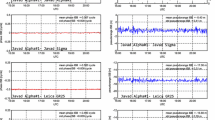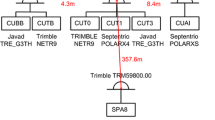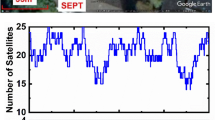Abstract
Relative positioning using multi-GNSS (global navigation satellite systems) can improve accuracy, reliability, and availability compared to the use of a single constellation system. Intra-system double-difference (DD) ambiguities (ISDDAs) refer to the DD ambiguities between satellites of a single constellation system and can be fixed to an integer to derive the precise fixed solution. Inter-system ambiguities, which denote the DD ambiguities between different constellation systems, can also be fixed to integers on overlapping frequencies, once the inter-system bias (ISB) is removed. Compared with fixing ISDDAs, fixing both integer intra- and inter-system DD ambiguities (IIDDAs) means an increase of positioning precision through an integration of multiple GNSS constellations. Previously, researchers have studied IIDDA fixing with systems of the same frequencies, but not with systems of different frequencies. Integer IIDDAs can be determined from single-difference (SD) ambiguities, even if the frequencies of multi-GNSS signals used in the positioning are different. In this study, we investigated IIDDA fixing for multi-GNSS signals of narrowly spaced frequencies. First, the inter-system DD models of multi-GNSS signals of different frequencies are introduced, and the strategy for compensating for ISB is presented. The ISB is decomposed into three parts: 1) a float approximate ISB number that can be considered equal to the ISB of code pseudorange observations and thus can be estimated through single point positioning (SPP); 2) a number that is a multiple of the GNSS signal wavelength; and 3) a fractional ISB part, with a magnitude smaller than a single wavelength. Then, the relationship between intra- and inter-system DD ambiguity RATIO values and ISB was investigated by integrating GPS L1 and GLONASS L1 signals. In our numerical analyses with short baselines, the ISB parameter and IIDDA were successfully fixed, even if the number of observed satellites in each system was small.










Similar content being viewed by others
References
Alber C, Ware R, Rocken C, Braun J (2000) Obtaining single path phase delays from GPS double differences. Geophys Res Lett 27(17):2661–2664. https://doi.org/10.1029/2000GL011525
Al-Shaery A, Zhang S, Lim S, Rizos C (2012) A comparative study of mathematical modelling for GPS/GLONASS real-time kinematic (RTK). In: Proceedings of ION GNSS 2012, Nashville, TN, September 2012, pp 2231–2238
Banville S (2016) GLONASS ionosphere-free ambiguity resolution for precise point positioning. J Geod 90(5):487–496. https://doi.org/10.1007/s00190-016-0888-7
Cai C, Gao Y (2013) Modeling and assessment of combined GPS/GLONASS precise point positioning. GPS Solut 17(2):223–236. https://doi.org/10.1007/s10291-012-0273-9
Doucet A, Freitas N, Gordon N (2001) Sequential Monte Carlo methods in practice. Springer, New York
Euler H, Schaffrin B (1991) On a measure of discernibility between different ambiguity solutions in the static-kinematic GPS-mode. In: Proceedings of the international symposium on kinematic systems in geodesy, surveying, and remote sensing. Springer, New York, pp 285–295
Force D, Miller J (2013) Combined global navigation satellite systems in the space service volume. In: Proceedings of the ION international technical meeting, San Diego, California
Gordon J, Salmond J, Smith F (1993) Novel approach to nonlinear/non-Gaussian Bayesian state estimation. IEE Proc F (Radar Signal Process) 140(2):107–113. https://doi.org/10.1049/ip-f-2.1993.0015
Han S (1997) Quality-control issues relating to instantaneous ambiguity resolution for real-time GPS kinematic positioning. J Geod 71(6):351–361. https://doi.org/10.1007/s001900050103
Julien O, Alves P, Cannon E, Zhang W (2003) A tightly coupled GPS/GALILEO combination for improved ambiguity resolution. In: Proceedings of the European Navigation Conference, pp 1–14
Kozlov D, Tkachenko M (1998) Centimeter-level, real-time kinematic positioning with GPS + GLONASS C/A receivers. Navigation 45(2):137–147. https://doi.org/10.1002/j.2161-4296.1998.tb02378.x
Kozlov D, Tkachenko M, Tochilin A (2000) Statistical characterization of hardware biases in GPS + GLONASS receivers. Proc ION GPS 2000:817–826
Leick A (1998) GLONASS satellite surveying. J Surv Eng-ASCE 124(2):91–99. https://doi.org/10.1061/(ASCE)0733-9453(1998)124:2(91)
Li T, Wang J (2011) Comparing the mathematical models for GPS and GLONASS integration. In: Proceedings of international global navigation satellite systems society symposium-IGNSS, Sydney, Australia
Li X, Ge M, Dai X, Ren X, Fritsche M, Wickert J, Schuh H (2015) Accuracy and reliability of multi-GNSS real-time precise positioning: GPS, GLONASS, BeiDou, and Galileo. J Geod 89(6):607–635. https://doi.org/10.1007/s00190-015-0802-8
Meindl M (2011) Combined analysis of observations from different Global Navigation Satellite Systems. PhD thesis. Astronomisches Institut der Universität Bern, Geodätisch-geophysikalische Arbeiten in der Schweiz
Melgard T, Tegedor J, Jong K, Lapucha D, Lachapelle G (2013) Interchangeable integration of GPS and Galileo by using a common system clock in PPP. In: Proceedings of ION GNSS, Nashville, TN, pp 16–20
Montenbruck O, Steigenberger P, Khachikyan R, Weber G, Langley R, Mervart L, Hugentobler U (2014) IGS-MGEX: preparing the ground for multi-constellation GNSS science. Inside GNSS 9(1):42–29
Nadarajah N, Khodabandeh A, Teunissen P (2015) Assessing the IRNSS L5-signal in combination with GPS, Galileo, and QZSS L5/E5a-signals for positioning and navigation. GPS Solut 20(2):289–297. https://doi.org/10.1007/s10291-015-0450-8
Odijk D, Teunissen P (2013a) Characterization of between-receiver GPS-Galileo inter-system biases and their effect on mixed ambiguity resolution. GPS Solut 17(4):521–53. https://doi.org/10.1007/s10291-012-0298-0
Odijk D, Teunissen P (2013b) Estimation of differential inter-system biases between the overlapping frequencies of GPS, Galileo, BeiDou and QZSS. In: Proceedings of the 4th international colloquium scientific and fundamental aspects of the Galileo programme, Prague, Czech Republic, pp 4–6
Odijk D, Teunissen P, Khodabandeh A (2014) Galileo IOV RTK positioning: standalone and combined with GPS. Surv Rev 46(337):267–277. https://doi.org/10.1179/1752270613Y.0000000084
Odolinski R, Teunissen P, Odijk D (2014) Combined BDS, Galileo, QZSS and GPS single-frequency RTK. GPS Solut 19(1):151–163. https://doi.org/10.1007/s10291-014-0376-6
Paziewski J, Wielgosz P (2015) Accounting for Galileo-GPS inter-system biases in precise satellite positioning. J Geod 89(1):81–93. https://doi.org/10.1007/s00190-014-0763-3
Teunissen PJG, Kleusberg A (1998) GPS observation equations and positioning concepts. In: Teunissen PJG, Kleusberg A (eds) GPS for geodesy. Springer, Berlin, Heidelberg, pp 187–229. https://doi.org/10.1007/978-3-642-72011-6_5
Tian Y, Ge M, Neitzel F (2015) Particle filter-based estimation of inter-frequency phase bias for real-time GLONASS integer ambiguity resolution. J Geod 89(11):1–14. https://doi.org/10.1007/s00190-015-0841-1
Tian Y, Ge M, Neitzel F, Zhu J (2016) Particle filter-based estimation of inter-system phase bias for real-time integer ambiguity resolution. GPS Solut. https://doi.org/10.1007/s10291-016-0584-3
Verhagen S, Teunissen P (2013) The ratio test for future GNSS ambiguity resolution. GPS Solut 17(4):535–548. https://doi.org/10.1007/s10291-012-0299-z
Wang J, Rizos C, Stewart M, Leick A (2001) GPS and GLONASS integration: modeling and ambiguity resolution issues. GPS Solut 5(1):55–64. https://doi.org/10.1007/PL00012877
Wanninger L (2012) Carrier-phase inter-frequency biases of GLONASS receivers. J Geod 86(2):139–148. https://doi.org/10.1007/s00190-011-0502-y
Acknowledgements
Yumiao Tian was financially supported by the China Scholarship Council (CSC) during his studies at the Technische Universität Berlin, Germany, and the German Research Center of Geosciences (GFZ), Germany. Zhizhao Liu thanks the grant supports from the National Natural Science Foundation of China (Grant NSFC 41274039), the Hong Kong Research Grants Council (RGC) Early Career Scheme (ECS) (Project PolyU 5325/12E (F-PP0F)), and the Hong Kong Polytechnic University (Project 4-BCBT).
Author information
Authors and Affiliations
Corresponding author
Rights and permissions
About this article
Cite this article
Tian, Y., Liu, Z., Ge, M. et al. Determining inter-system bias of GNSS signals with narrowly spaced frequencies for GNSS positioning. J Geod 92, 873–887 (2018). https://doi.org/10.1007/s00190-017-1100-4
Received:
Accepted:
Published:
Issue Date:
DOI: https://doi.org/10.1007/s00190-017-1100-4




